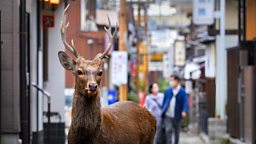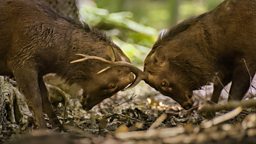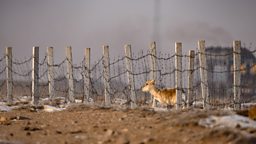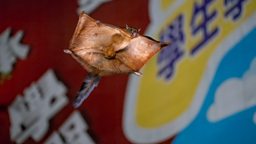The marvellous Nara deer
By Emma Hatherley, Producer

Across Asia, there are a few places where animals and people live at extraordinarily close quarters. One such place is Nara, a city in central Japan. Within minutes of arriving, I spotted two sika deer casually lounging in the city centre, unfazed by the hundreds of commuters rushing past. It was my first glimpse of the famous ‘Nara deer’. Taking a walk to shake off my jetlag, I spotted deer napping in the shade of a museum, cooling off in city fountains and even using the zebra crossing. To me, these sights were delightful and photo-worthy but, in Nara, they are nothing out of the ordinary.
Deer and people have lived together here for hundreds of years, thanks to deep-rooted spiritual beliefs.
Deer and people have lived together here for hundreds of years, thanks to deep-rooted spiritual beliefs. Considered sacred, the deer are not only protected, but hand-fed specially-made deer crackers. Nara deer have a reputation for bowing politely to request a cracker but I soon discovered that the reality isn’t always so well-mannered. Determined deer pursued alarmed tourists down the road, repeatedly nudging them until they surrendered entire packets of crackers. Watching this, it occurred to me just how fine the line is between a genteel bow and a gentle headbutt.
We’d travelled to Nara with the goal of filming a very specific behaviour. One that sounded improbable yet we knew existed, from a single clip we’d unearthed online. It’s a tense, watch-behind-your-fingers clip, in which two stags engage in a ferocious battle. But, remarkably, only one of the males has antlers. The other appears intensely vulnerable but, somehow, holds his own. This mismatched battle had broken out in Nara because, every rutting season, males have their antlers removed to avoid accidents with people. As a result, most males in the centre of town don’t have antlers – but males living around the outskirts still do. Inspired by the clip, we had arrived in Nara determined to tell the story of a brave, antler-less male engaging in a battle without weaponry.

Before committing to filming, our Japanese fixer Mai had visited Nara to research these mismatched fights and determine our chances of filming one. She’d spoken with people who work with the deer and, reassuringly, most people confirmed that they had witnessed, or at least heard of, such conflicts. But when asked when and where they break out, the answer always came back, “Fights break out anywhere and anytime”. With over twelve hundred deer roaming through every corner of the city, and just three weeks in Japan, being at the right spot at the right time felt dauntingly improbable.
Apparently, this is all intensely threatening...
Our strategy was to split into teams to allow us to cover maximum ground. Heavy-duty wheeled trolleys meant we could run with the bulky filming kit, the tarmacked urban surfaces working to our advantage. Mai hired an electric bike to create a highly mobile scouting unit. Around 5:00 am, just before dawn, we’d begin our silent patrol of the empty streets, Mai gliding on her e-bike, whilst scanning the shadows for any dark shapes that could be sleeping stags. This was my favourite time of day, the ancient city peaceful before the build-up of traffic and tourists.
As the deer began their days, our three teams were in constant contact. Pictures, videos and location pins flew between us, as we tried to predict which males would make the first move. Luckily for us, fights are preceded by an elaborate display, a theatrical performance that signals intent. First, two males commence a sideways crab-style walk, taking a path parallel to each other. Turning their heads away from each other, they eyeball their opponent suspiciously. For extra comedic effect, they may stick their tongue out and let it flop at a jaunty angle. Apparently, this is all intensely threatening: a signal that a stag is prepared to fight.

For us, it was the cue to leap into action and begin the exhausting process of continuously repositioning the heavy camera and tripod. We’d soon become very good at running with tripods: it turned out that the pre-fight display could go on, and on, without ever resulting in battle. We’d follow pairs of stags for what felt like hours, constantly repositioning the camera to ensure a clear view. Then, presumably in response to a cue too subtle for us to detect, the two males would relax and casually wander off in opposite directions.
...finally, a male without antlers made his way to the glade...
Thanks to our roaming tactics we soon got to know the deer’s semi-predictable daily routines. We discovered popular sleeping sites and learned which parks were preferred grazing spots at different times of day. One particular place caught our attention, as it appeared to have all the ingredients to stage a mismatched fight. It was a wooded glade, in the grounds of an ancient shrine. Females grazed there in the mornings, watched over by a large stag, still sporting an impressive pair of antlers. It was likely that he’d won this territory in battles that had taken place before we’d arrived. However, there was the possibility that another male would challenge him. To take on the intimidating stag would be high risk but, with so many females in the glade, also high reward.
One team committed to begin each day in the wooded glade. At first, mornings were frustratingly uneventful: the stag and females quietly grazed until around eleven, when they’d head towards a park in search of fresh grass and leave the dejected crew alone in the forest. But, finally, a male without antlers made his way to the glade, clearly interested in the females. His body size was in the same ballpark as the antlered stag which meant there was a chance he would challenge. On that first morning he left without making a move, but his presence was enough to fill the team with hope and, when he returned the next day, they were ready. The sideways crab walk commenced, and the crew began their own well-rehearsed routine, moving the camera to ensure an unobscured view when, or if, battle broke out.

Without any obvious warning, the males charged, their bodies colliding with a resounding thud. This was it. Fast, furious and almost impossible to follow. The stags, bodies locked together, competed to gain ground and moved considerable distances with no predictability. They’d disappear behind trees, forcing the crew to make the agonising decision of whether to move and risk missing essential action, or stay put and hope they would quickly re-emerge.
I had begun to see the town through their eyes...
After an intense and sustained battle, the stags finally broke apart, exhausted. It was too early to celebrate: such fast-paced action is captured at high frame rates and it’s only later when reviewing on a larger screen that you can be sure the key parts of the image are in pin-sharp focus. In a few hours’ time there would be cheers from the entire crew, all crowded around a laptop in a cramped hotel room. But for now, the team stayed focused on the aftermath: the antlered male walking away, the underdog approaching the females.
When I first arrived in Nara I’d been struck by the strangeness of deer inhabiting the human world. Now, after long days following the deer and attempting to second-guess their movements, I had a new perspective. I had begun to see the town through their eyes: divided into territories, with parks a source of fresh grass and certain streets the destination for a tasty treat. The unique co-existence in Nara is a striking reminder that boundaries between the ‘human world’ and the ‘wilderness’ don’t really exist. As the human population grows, our homes increasingly overlap with those of other animals. The deer, and the people, of Nara are testimony to the possibility of finding ways to share space and live peacefully alongside each other.

The extraordinary deer of Nara
In one special Japanese city, sika deer live side by side with humans.



































